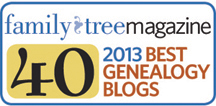Thankful Thursday: NERGC 2013
Today was my first day at the New England Regional Genealogy Conference. It is being held at the Radisson Hotel in Manchester, New Hampshire. The theme for this year’s conference is “Woven in History – The Fabric of New England”. It’s not too late to attend. If you will be in the Manchester. New Hampshire area come on down for the day. A full day of lectures are scheduled for Friday and Saturday.
My day started off with a 3.5 hour drive from my home in the western part of Connecticut to Manchester, New Hampshire. I arrived well before the 10:00am opening session and checked in. The opening session was presented by Sandra MacLean Clunies, CG. It was about the “Millhand Migrations to 19th Century Lawrence and Lowell”. Although, I did not have ancestors or related relatives who worked in mills in Lawrence or Lowell, many of my ancestors worked in mills elsewhere in New England. It provided a glimpse of what life was like moving from a rural farmland into a city and why women of the time were drawn to this type of work.
There were 20 difference lectures offered in the afternoon at various times. I was able to attend three lectures. The first lecture I attended was “Not Just the Facts Ma’am, Give me the Big Picture”. Colleen Fitzpatrick does a wonderful job at analyzing the photographic evidence of a man sitting on a dead horse. Using forensic methodologies, she has narrowed down the date and time the photo may have been taken one of two dates. The lecture shows how paying attention to details within a photograph may lead to surprising discoveries.
After that lecture, I attend one by Laura Murphy DeGrazia, CG. Her talk was about “What is a ‘Reasonably Exhaustive’ Search?”. This is one criteria to adhere to the Genealogical Proof Standard. The case Laura was describing started out with what seemed to be reasonable conclusions based solely on looking at some of the standard genealogical sources, census records and some primary records. However, this did not represent a ‘Reasonably Exhaustive’ Search. After looking at more records we found that a second marriage took place and that the children who at first seemed to belong to one parent actually belonged to a second spouse. It demonstrated that in order to draw correct conclusions a ‘Reasonably Exhaustive’ Search must be undertaken.
The final lecture I attended for the day was “Complex Evidence – What it is? How it Works? Why it matters?”. It was given by F. Warren Bittner. This was the lecture I enjoyed the most today. Warren takes a case study to find the identity and prove the relationship of one individual with her parents. He shows how the Genealogical Proof Standard (GPS) is applied to a real life case study. The GPS standard consists of the following;
- Relatively exhaustive research
- Complete citations for each source
- Analyze and compare the data
- Resolve conflicting evidence
- Write a conclusion based on the evidence
Warren demonstrated that no one source really proved the identity or relationship. However, when about thirty resources were put to the GPS standards and cross referenced to each other you can draw a correct conclusion. This analysis involved looking at primary and secondary sources, direct and indirect evidence as well as original and derivative evidence.
After the lectures were completed for the day, the society fair with a happy hour and later the exhibition hall was opened. There were a lot of genealogical vendors. It was great and I enjoyed walking through and stopping at each booth to see what each vendor had.
I’m looking forward to tomorrow’s day at the conference.


Jim, congrats on being among the Top 40 Blogs! – Marian
Thank you Marian. I had no idea I was even being considered.
Regards, Jim